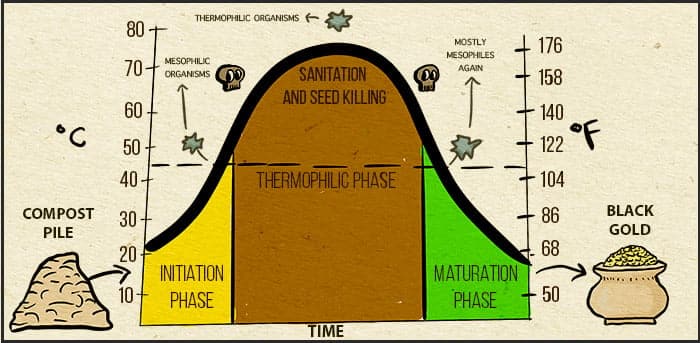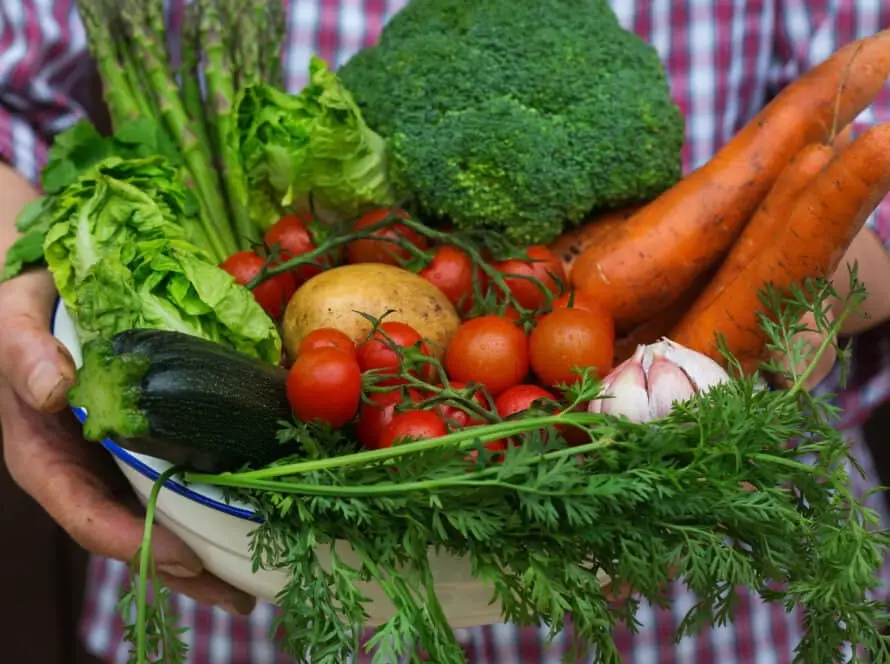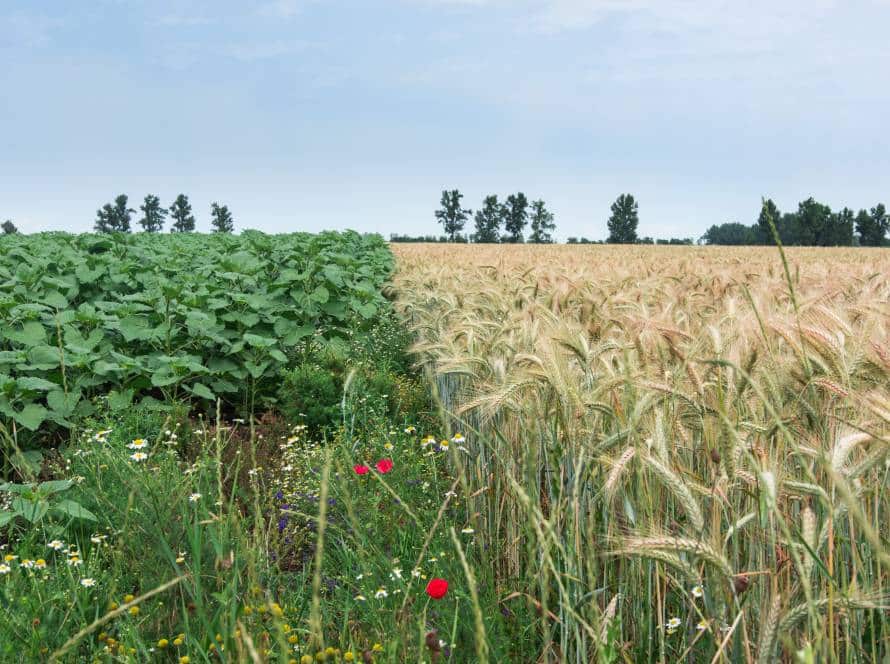Thermophilic composting and Mesophilic composting or vermicomposting are two of the best-known processes for the biological stabilization of solid organic wastes…
Vermicomposting, which involves the bio-oxidation and stabilization of organic material by the joint action of earthworms and micro-organisms, results in a more homogenous product, in my opinion.
Probably the most misleading word associated with vermicomposting is that it includes the word “composting”.
In the process of composting, microorganisms break down organic matter and produce carbon dioxide, water, heat, and humus, the relatively stable organic end product. Under optimal conditions, composting proceeds through three phases: 1) the mesophilic, or moderate-temperature phase, which lasts for a couple of days, 2) the thermophilic, or high-temperature phase, which can last from a few days to several months, and finally, 3) a several-month cooling and maturation phase.
Thermophilic composting has been achieved mostly in windrows or bins where organic materials such as tree and grass cuttings, manures, food wastes etc., are piled in heaps less than 2.5 metres high (to avoid spontaneous combustion) and with correct moisture and aeration the bacteria present on and in the materials begin to consume those organic materials.
Evidence of their activity can be felt in just a few hours or so, as the material heats up to between 60 and 70 degrees Celsius. These heaps need to regularly be moistened correctly and turned to aerate again to maintain the ongoing activity of the microbes.
The composting process is almost entirely dependent on the health and “happiness” of the micro-organisms within your compost pile, or windrows. And aside from adequate oxygen and moisture levels, your microbes need a couple of more VERY important things to thrive – they need the right balance of compost ingredients.
On a very basic level, the dietary requirements of the micro-organisms in your compost are not very different than those of the typical human being. That is, just like us, your microbes use carbon for energy and growth, and they use nitrogen for protein and reproduction. If you remove either of these components, or overfeed your microbes too much carbon or nitrogen, you can kiss your chances of making high-quality compost good-bye.
Scientists have determined that the fastest way to produce fertile, sweet-smelling compost is to maintain a C:N ratio somewhere around 25 to 30 parts carbon to 1 part nitrogen, or 25-30:1. If the C:N ratio is too high (excess carbon), decomposition slows down. If the C:N ratio is too low (excess nitrogen) you will end up with a stinky pile.
Traditionally 8 months of this process followed by a further 2 – 4 months of stabilising produced a suitably well prepared and almost seed free organic material – great for holding in soil moisture, retaining banks prone to erosion or retarding the growth of weeds. And yes, the basis of a good soil medium for potted and growing plants.
These days most serious composters now employ in-bed or above bed aeration pipes where air is pumped up or sucked down through the mix to speed up the aerobic breakdown of the organics being processed. Thus, in 4 to 6 months a similar product is produced.
Many worm farmers around the world use such in-vessel composting for 40 or so days then cool and place the material on raised worm beds for a further 40 days and sell the output a ‘castings’ where it is really only ‘worm-worked’ composted material – far less nutrient rich than true 100% castings.
Mesophilic composting (in opposition to thermolytic composting) is an aerobic micro-organism-driven decomposition of organic matter at low temperatures (the mesophilic range). Mesophilic bacteria thrive from 20 to 30 degrees Celsius but just survive at temperature above 40 degrees Celsius.
Compost/Manure worms likewise struggle to survive in less than 15 degrees Celsius or over 30 degrees Celsius. Worms ingest through their tinny mouths organic materials turning to soup through the action of anaerobic bacteria present in manures, for instance, from the gut of the animal excreting it. Bacteria are the smallest living organisms and the most numerous in compost; they make up 80 to 90% of the billions of microorganisms typically found in a gram of compost.
The worms are nourished by digesting these bacteria-rich soups then seed their castings (poop) with aerobic bacteria from their own gut. They also eat various actinomycetes, protozoa, fungi and rotifers present in the organic material, multiplying and feeding on the same wastes. They are further assisted in converting organic materials by untold numbers of tiny bugs, critters and minute creatures – not a very scientific statement but they come from everywhere. You can see them all through a healthy mix.
The end product which can take from 12 to 18 months, to build to 1m deep, is a collection of super fine sticky particles forming aggregates that hold together well even in the wet; it is dark and pleasantly earthy smelling; and is approximately 24% solids so it feels like a non-drippy moist mousse with quite plastic properties allowing it to be shaped by hand and to hold that shape even when stacked in blocks, despite the quantity of water present. At a metre deep it still does not slump or collapse in on itself easily, even if undercut up to half a metre. But this only applies to 100% ‘REAL’ worm castings – not thermophilic compost.
Every particle that has gone through a worm’s crop has been ground to a minute size then once pooped out is re-eaten by other worms, over and over again. The particles are finer than talcum powder so once diluted with more water appropriately, can be sprayed through watering sprinklers without blocking them.
N:P:K testing shows that there are high levels of mineralised nitrogen, phosphorus and potassium as already present in the organics but note, it is already mineralised and ready for speedy uptake and digestion by plants. Also containing an abundance of Humic acid, powerful growth stimulants, and more. As the plants thrive from seed to fruiting, they have noticeably greater disease resistance, bug resistance, healthier, deeper root systems, fruit sooner, more, bigger and tastier – and this is not an exaggeration.
Unlike chemical fertilisers, ‘REAL’ castings actually add to the soil – building your soil – with the best and naturally produced topsoil. It also encourages burrowing earthworms to come, breed and give their free gift of aeration, burrows that hold up, allowing water easy access into the soil and root systems easy access to more food and water sources available deeper or wider. As these worms burrow, they leave traces of nitrogen slime on the walls which further encourages plant roots to extend.
Because many species of birds cannot resist eating fat healthy worms they come too and while they are at it also consume more of the flying, crawling pests that would otherwise attack plants. Another win- win situation.
Can you see the difference yet, between traditional (HOT) composting and vermicomposting (COLD)? Thermophilic composting requires correct ratios of Nitrogen to Carbon, sufficiently suitable bacteria, regular turning &/or aeration, correct moisture as required, sufficient time and temperatures above 60 degrees Celsius for sustained periods and close monitoring. This process is also not without noise, dust and odours.
Mesophilic composting requires suitable organic materials for billions of bacteria and numerous worms to consume, NO HEAT above 30 degrees Celsius, suitably maintained moisture levels, suitable pH, sufficient compost-manure worms to handle the organic wastes, reasonable time, and countless other small creatures that appear, to assist the worms with consuming, breaking down and building castings aggregates – Nature’s bases of excellent soils. They all work synergistically together with virtually no nuisance or noise, a pleasant, earthy smell and no dust. Clever Mother Nature perfected this art many thousands of years ago – you can’t improve on perfection!
You can choose to labour with composting yourself – it will
take about a year to bear best fruits. It can be strenuous but rewarding. You
can try running an active worm bin or bed and gather your own beautiful
castings as long as you are vigilant and have sufficient suitable ‘foods’
available and care for the welfare of the worms.
Both methods require commitment, attention to detail, some
effort and some form of expense.
On the other hand, Vermicycle has done it all for you. Expertly
produced castings full of all the most plant-needed microbes, mineralised
nutrients and soil building structures. Any plant or animal diseases possibly
found in organic wastes are eliminated by our worms and beneficial microbes
replace them.





